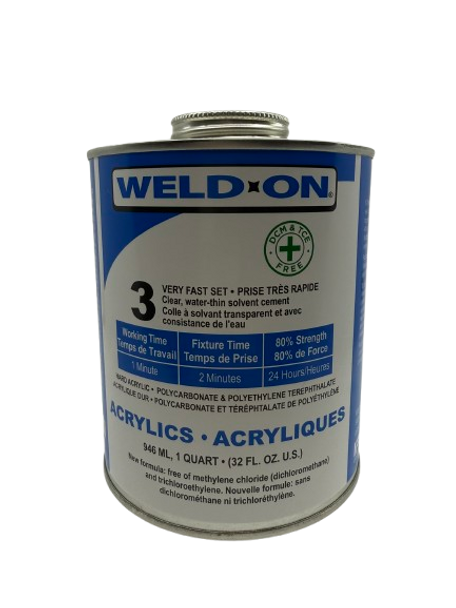SCIGRIP IPS Weld-On #3 (DCM & TCE Free Formula) – Fast-Set Solvent Cement for Acrylics
- Weight:
- 0.00 LBS
Description
Weld-On 3 (DCM & TCE Free Formula) is a water-thin, non-flammable cement formulated to quickly develop high strength, clear bonds to many thermoplastic substrates, particularly acrylic. The bond is achieved by first softening the surfaces to be joined and then fusing them together with dissipation of the solvent. The initial bond forms within a few minutes and quickly increases in strength. Substantial strength will be obtained within only a few hours. Under certain conditions, especially with high humidity, a white mark on the plastic (commonly called blushing) may sometimes be encountered. Where a more blush-resistant cement and longer open time is required, Weld-On 4 is recommended.
Substrate Recommendations
Weld-On 3 (DCM & TCE Free Formula) is formulated for cementing acrylic (poly-methyl methacrylate) plastic to itself. It is not recommended for cross-linked acrylic.
Bonding Recommendations
Weld-On 3 is used extensively in sign fabrication. Strong butt joints are made with flat sheets by using the soak method for such applications as cementing letters to acrylic panels. Butyrate trim-capping of acrylics is another highly recommended use for Weld-On 3. It is also widely used in the POP industry (e.g., display), and in the fabrication and bonding of plastic containers, housewares, bottles and many other applications using the capillary method.
Additional Information
This product is not for general consumer use. It is an industrial product intended for professional use only. Plastic-Craft Products reserves the right to substitute similar quantity Weld-On 4SC for Weld-On 3 or Weld-On 4 when ordered by an individual consumer.
This product may not be shipped into Los Angeles, San Bernardino, Orange, or Riverside Counties. Plastic-Craft Products reserves the right to substitute Weld-On 4SC for Weld-On 3 or Weld-On 4 when ordered for delivery to zip codes in those counties.
Technical
Typical Bond Strength†
| Substrate Material | Aged Bond Strength, lbs/in2 (kg/cm2) | ||
| 2 Hours | 24 Hours | 1 Week | |
| Acrylic (Cast & Extruded) | 800 (56.3) | 2,000 (140.6) | 2,500 (175.8) |
† Substrate thickness: 0.25 inch (0.64 cm). Bond area: 1.0 in² (6.45 cm²). Ultimate Bond Strength is defined as strength achieved after 24-hour room temperature cure.
Adhesive Properties and Characteristics @ 73°F (23°C)
| Color | Clear |
| Viscosity | Water Thin |
| Working Time | 1 Minute |
| Fixture Time (Time to reach 80% of ultimate strength) | 2 Minutes |
| Time to reach Ultimate Bond Strength | 24 Hours |
| Specific Gravity (g/cc) | 1.330 ± 0.01 |
| Formula | DCM & TCE Free |
Directions
Directions for Use
General: Surfaces to be joined must be clean, dry, and fit intimately without forcing. Apply cement with syringe, eyedropper or brush. Assemble while parts are still wet. If cement is applied to one surface, let the two surfaces be in gentle contact for a few seconds to allow the cement to soften the dry surfaces, then press parts together in firm contact. Initial bonds form very quickly. 65–80% of the ultimate bond strength will be obtained within 24 hours. Strength will continue to increase for several weeks.
Capillary Method: Parts are placed lightly together and cement is applied to the edge of the joint with syringe or eyedropper. By capillary action, the cement will flow a considerable distance, approximately 0.25 inch (0.64 cm), between two such surfaces. Allow a few seconds for the cement to soften the surfaces. Press parts firmly together.
Soak Method: Vertically dip surfaces until softened (approximately 2 to 5 minutes), then join pieces firmly together.
- In many cases, this cement dries too fast to apply by brush to the parts before they are joined.
- If crazing is a problem, we suggest you consider annealing before cementing.
Shelf Life
Two years in tightly sealed containers. The date code of manufacture is stamped on the bottom of the container. Stability of the product is limited by the evaporation of the solvent when the container is opened. Evaporation of solvent will cause the cement to thicken and reduce its effectiveness. Adding of thinners to change viscosity is not recommended and may significantly change the properties of the cement.
Safety
Safety Data Sheet (SDS) – DCM & TCE Free Formula
Safety and Environmental Precautions
This product is a non-flammable, very fast-evaporating solvent cement and should be handled with care. It is considered a hazardous material. Purchasers who may re-package this product must conform to all applicable local, state, and federal labeling, safety, and other regulations.
WARNING! VAPOR HARMFUL. MAY BE HARMFUL IF SWALLOWED. MAY IRRITATE SKIN OR EYES.
Keep out of the reach of children. Do not take internally. Keep away from heat, spark, open flame and other sources of ignition. Keep container closed when not in use. Store away from direct sunlight below 80°F (27°C). Use only with adequate ventilation. Avoid breathing vapors; maintain airborne levels below established exposure limits. Where exposure may exceed limits, use appropriate respiratory protection as specified in the SDS. Do not smoke, eat, or drink while working with this product. Avoid contact with skin, eyes, and clothing. Use suitable protective equipment (gloves, goggles, impervious apron). Carefully read the SDS and follow all precautions.
Regulatory disclosures (including any Proposition 65 statements) and full ingredient information are provided in the current SDS linked above.
First Aid
Inhalation: If overcome with vapors, remove to fresh air. If not breathing, give artificial respiration. If breathing is difficult, give oxygen. Call a physician.
Eye Contact: Flush with plenty of water for 15 minutes and call a physician.
Skin Contact: Wash skin with plenty of soap and water for at least 15 minutes. If irritation develops, get medical attention.
Ingestion: If swallowed, give 1 or 2 glasses of water or milk. Do not induce vomiting. Contact physician or poison control center immediately.

